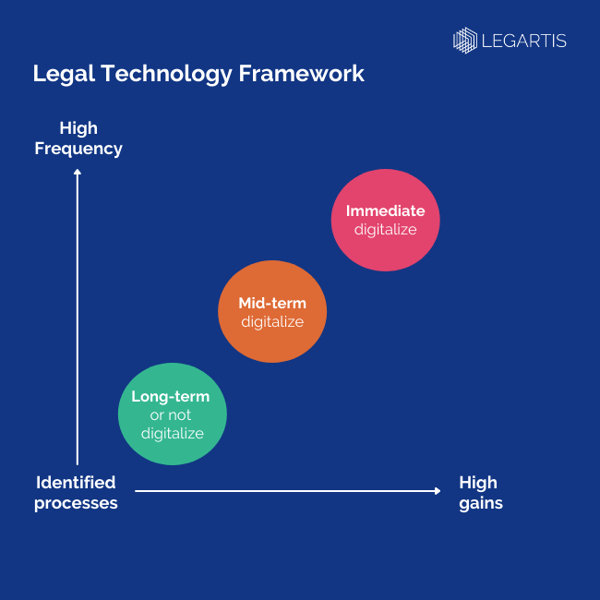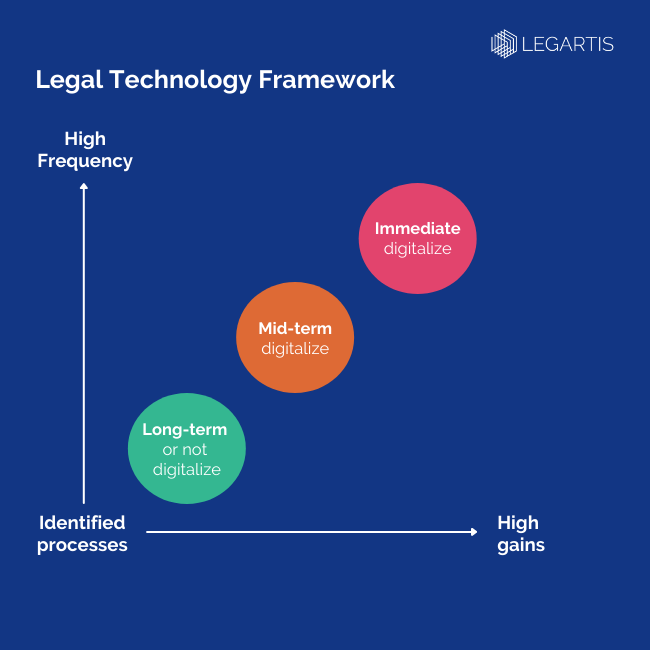Companies are rolling out digitalization across departments. The objective: to make organizations more streamlined, agile and faster so that they can withstand increasing pressures from their competitors.
The use of AI in companies is no longer uncharted territory. The Legal Technology sector is also seeing rapid growth in the market. Legal departments are under increasing pressure to take advantage of digitalization opportunities as a means to raise productivity and efficiency.
It is therefore necessary to provide an overview and establish where and how technology can best serve legal departments. With the jungle of technology and the sheer quantity of digital solutions available, it’s not easy to find the right one to start out with.
Where technological know-how is lacking, it is recommended you: Don’t start out with your biggest project. Gain experience using a solution that helps you solve your initial problem!
In this article, we'll show you why when it comes to technology adoption, it's often the small steps that lead to faster success.
Legal Technology: Begin with smaller steps
Those in charge in the legal department often think that a contract management system needs to be in place before other processes can be automated. However, there is something legal departments can learn from other companies and departments - if they want to accelerate their work, they shouldn’t start off with their biggest projects. Instead, they should gain experiences that they can build upon.
For example, not all processes need to be automated all at once - taking partial steps towards greater efficiency will help speed up the digitalization of the legal department, because with each step climbed, the team’s technological understanding and capabilities will continue to grow.
“When digital transformation is done right, it’s like a caterpillar turning into a butterfly, but when done wrong, all you have is a really fast caterpillar.”
George Westerman, Principal Research Scientist, MIT Sloan School of Management
Think in partial steps
Experience from digitalization initiatives shows that departments with in-depth technological expertise in particular do well not to digitalize all their work processes right away. The disillusionment and frustration at the fact that digitalization projects are lengthy and bring unpredictable setbacks, very high internal resource input and high coordination effort between company systems is poorly rated among employees. This has a significant impact on how well they will embrace the technology later on. Moreover, the highly motivating successes usually only occur much later on - until this point, the team will continue to work sluggishly with the old processes.
Here, it is helpful to think a little leaner. In order to move from a sluggish to a more agile way of thinking, legal departments should ask themselves: Are there processes that are often repeated and demand a lot of resources from the team? Can these not be automated immediately (e.g. automated contract review)? What will help us to become leaner in the short, long and medium-term and advance our organization’s growth?
In order to increase the team’s technological understanding and competency for future roll-outs of larger systems, it helps to introduce technology in partial steps: a streamlined approach that quickly enables technological experiences and moves the team step by step into digital workflows.
Bring the team along on the journey from the very start
Internal obstacles and fears come top of the list when there has been a failure to introduce new technology. New systems force users to take a new approach to a process or completely adapt it. To help company lawyers along the way to new technology, it helps to begin with one process that could be digitalized or automated.
The team should be integrated from the very beginning in the question: where is the most action currently required, where would automation relieve us, which process consumes a vast amount of resources?
Identifying a common problem boosts acceptance when a solution is later implemented. Additionally, the team should then be committed to solve this problem and improve the process. For the subsequent evaluation and implementation of the project, a project manager is needed to inform and guide the team throughout the process.
Analysis of the legal problem
Teams should carry out an analysis that will provide insight as to where a piece of technology will bring added value to the team.
They should ask themselves the following questions:
-
Which processes are putting a strain on the team (resources, time, costs)?
-
Which processes are repetitive (prone to errors) and occur frequently?
-
Which processes would benefit from standardization and automation?
-
What do both the team and the company stand to gain from this automation process?
Once the processes, their frequency and the gains expected to be made such as time-saving, simplified cooperation and higher productivity have been identified, they can be clustered using the Legal Technology Framework below.
The framework shows which processes should be digitalized immediately, medium or long-term.

The findings of such analysis are helpful in making the team appreciate the new technology, as they are familiar with its benefits from the very beginning.
Legal Technology Selection: Quick initial successes
Yes, there are many suppliers on the market. However, the choice is much smaller now that the processes requiring digitalization have been clearly identified.
Now the project manager faces other questions that they should answer in the backdrop of a short-term digitalization drive:
-
How well does the technology solve our problem?
-
Can the solution be flexibly adapted to the existing and future company systems?
-
Does the solution make it harder to implement other systems?
-
How complex is the technological implementation?
-
How well will the team be supported by the provider during the introduction of the technology?
-
How easy is its application (user experience)?
-
How quickly can the initial successes be seen (experiences gained)?
These questions do not cover all the criteria that suppliers will have to answer when selecting technological solutions. However, they provide the direction that the project manager should be guided towards.
 Key takeaways
Key takeaways
People often ask if they should first solve the big problems such as the introduction of a contract lifecycle management system before they optimize other processes. The answer to this question is: No. Introducing complex systems slows down a legal department’s digitalization process and the build-up of technological know-how, and it takes some time for the employees and the company to see the benefits of increased efficiency.
As with any technological initiative, experience must be gained, starting with the smaller steps. This is best suited to processes that are often repeated and entail a lot of repetitive, manual work. Clustering processes according to their frequency and profit potential using this Legal Technology Framework helps identify which digitalization steps should be taken now, tomorrow or much later in the future.
The conscious choice of technology that helps solve one specific problem, but not all of them, speeds up the process of introducing legal tech in legal departments.
Legartis’ Legal AI solution focuses on the process of reviewing contracts. Read more about this in our solution brief.
Recommended Articles
Agentic Legal AI: When AI Shifts from Assistant to Actor
The days when AI in the legal industry was little more than a glorified spell checker are over. What sounded like science fiction just a few years ago is now reality: Agentic..
Agentic AI: Automated Generated Contract Playbooks
Every day, countless agreements are drafted, negotiated, and signed. For legal departments, legal-ops teams, and procurement leads, it is essential to keep track: Which..
Trends 2025: AI in Contract Analysis
The latest trends in Large Language Models (LLMs) show a shift towards greater efficiency, advanced AI agents and wider adoption across all industries. AI models are becoming..



